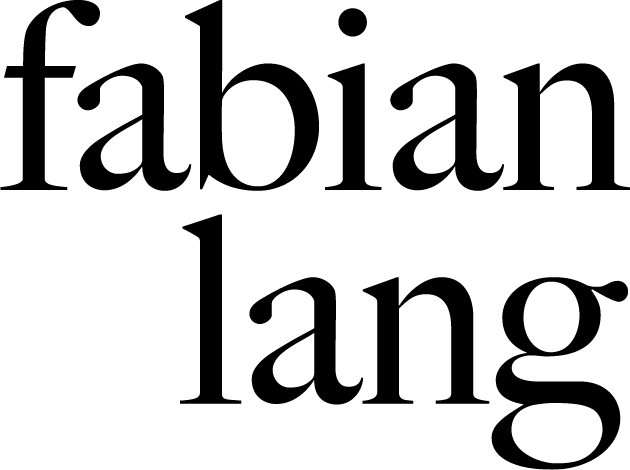Set for Four Players, a Sundial and a Bear
CHRISTIAN HIDAKA & RAPHAËL ZARKA
5 March - 30 April 2021
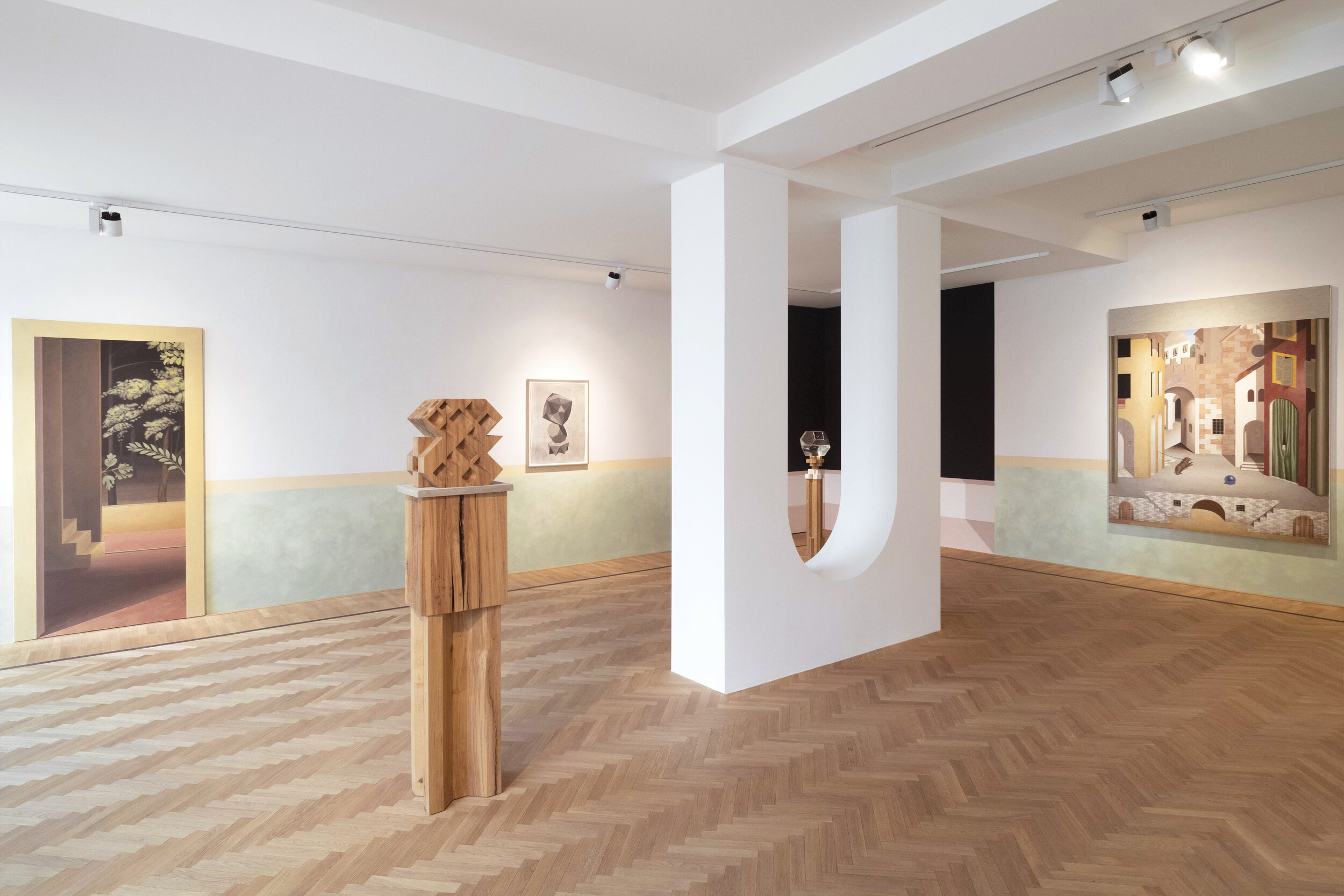
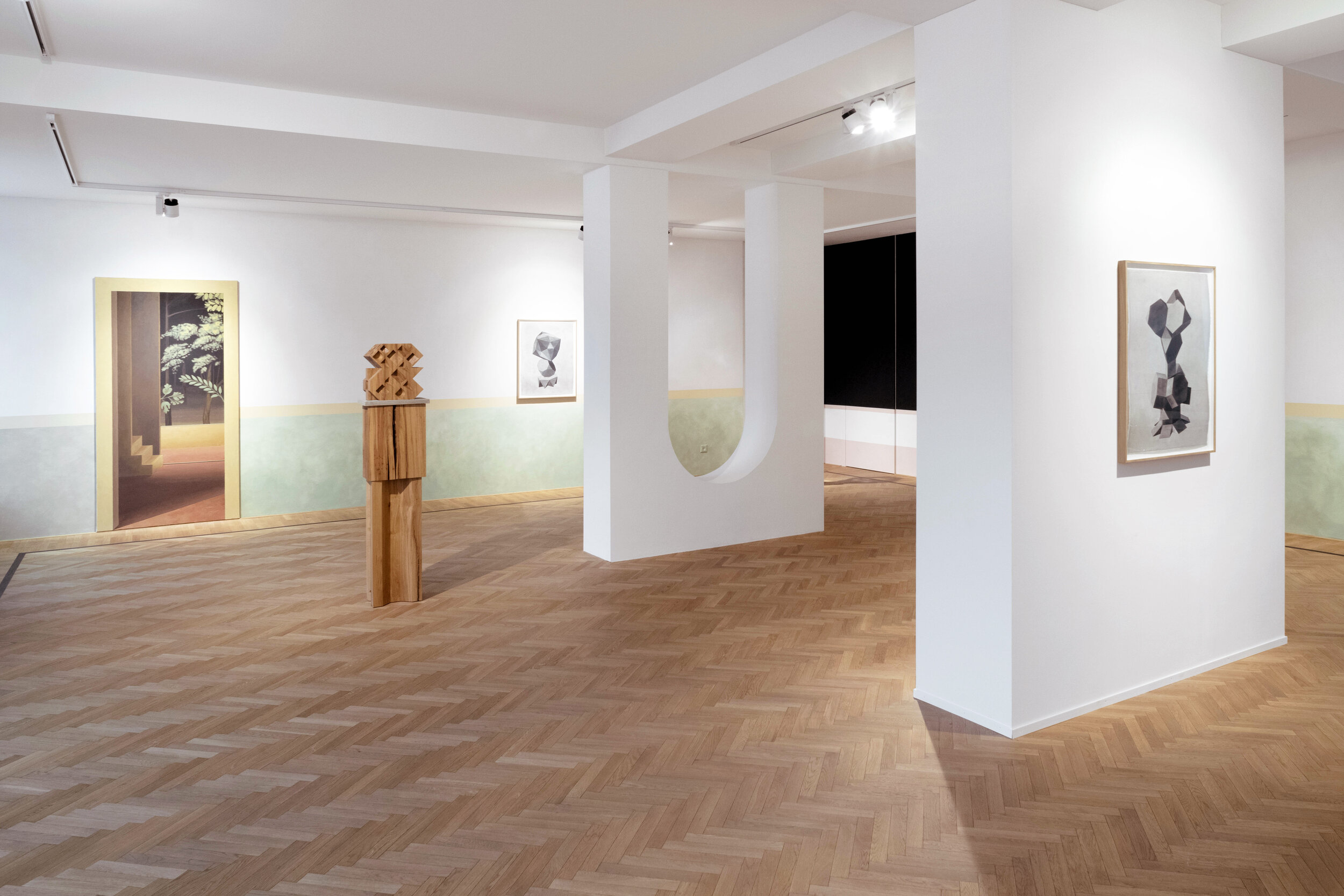
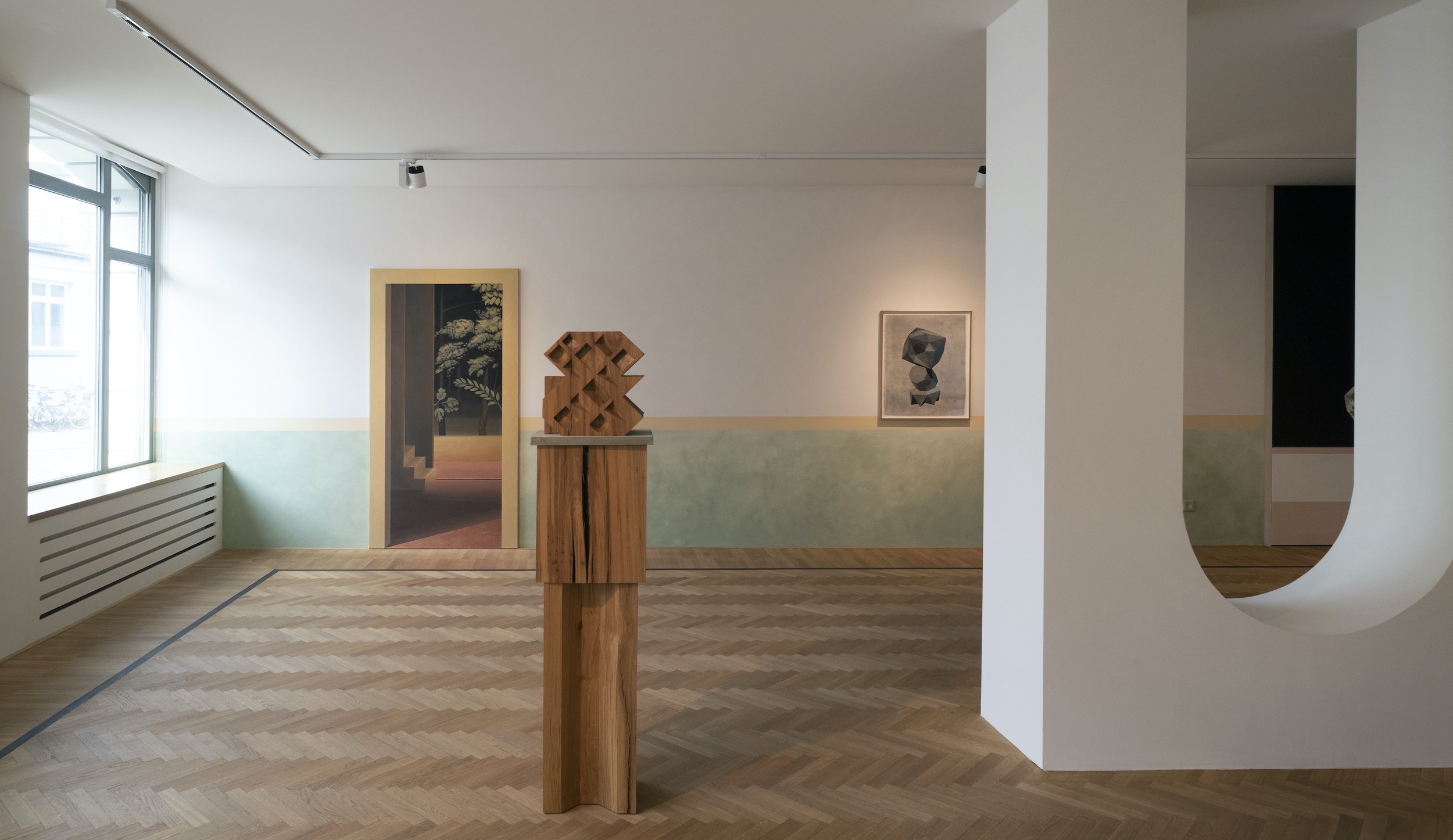
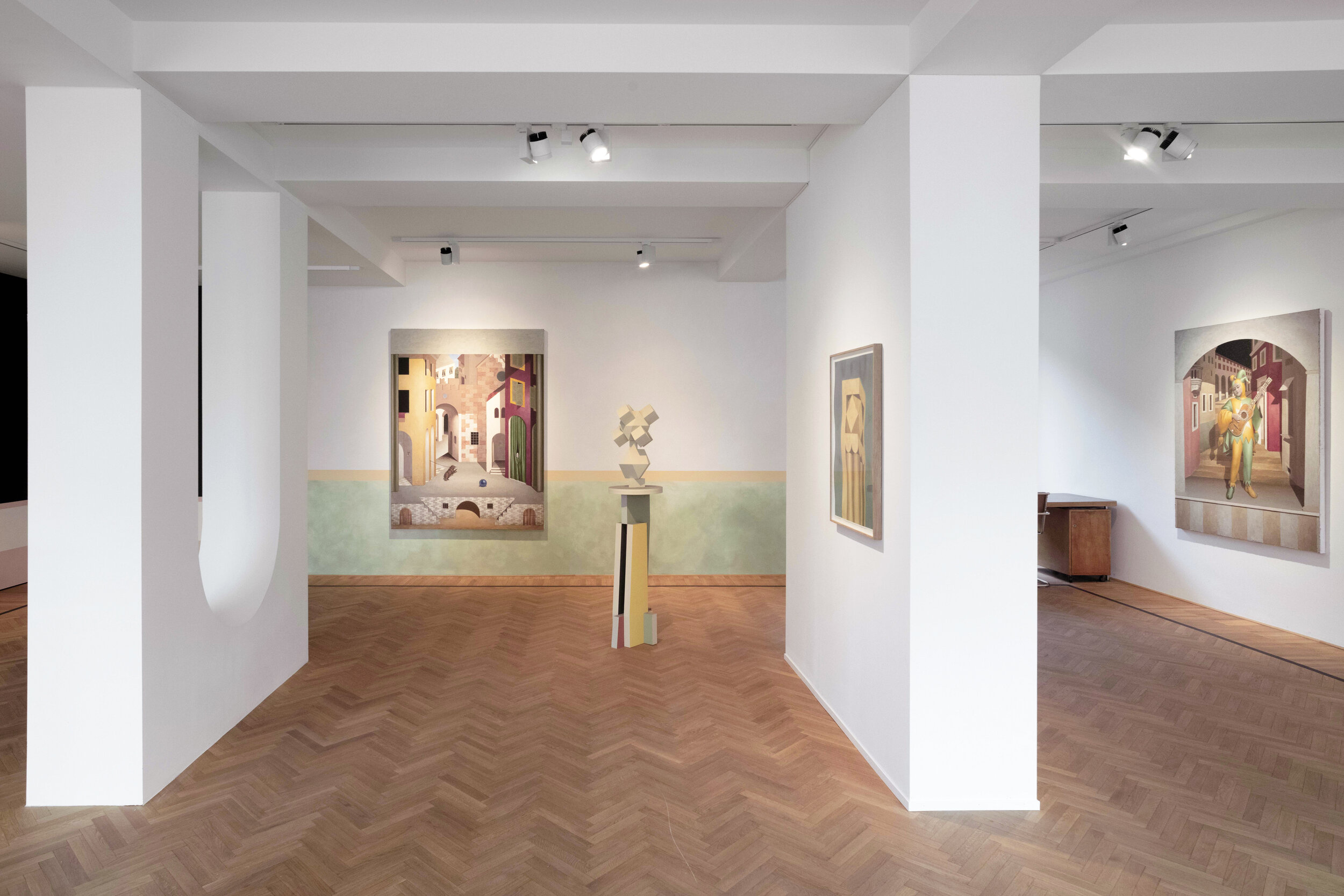
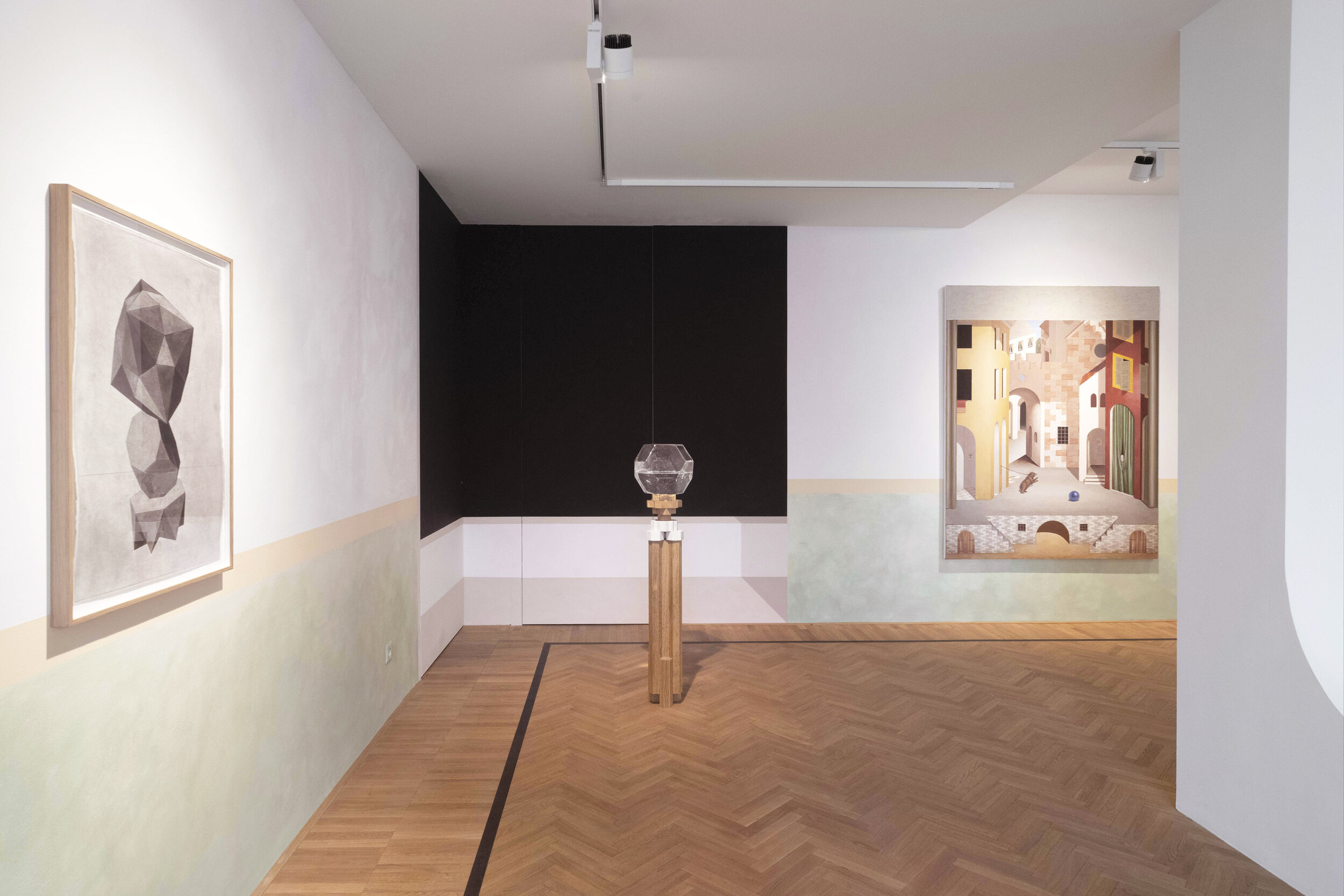
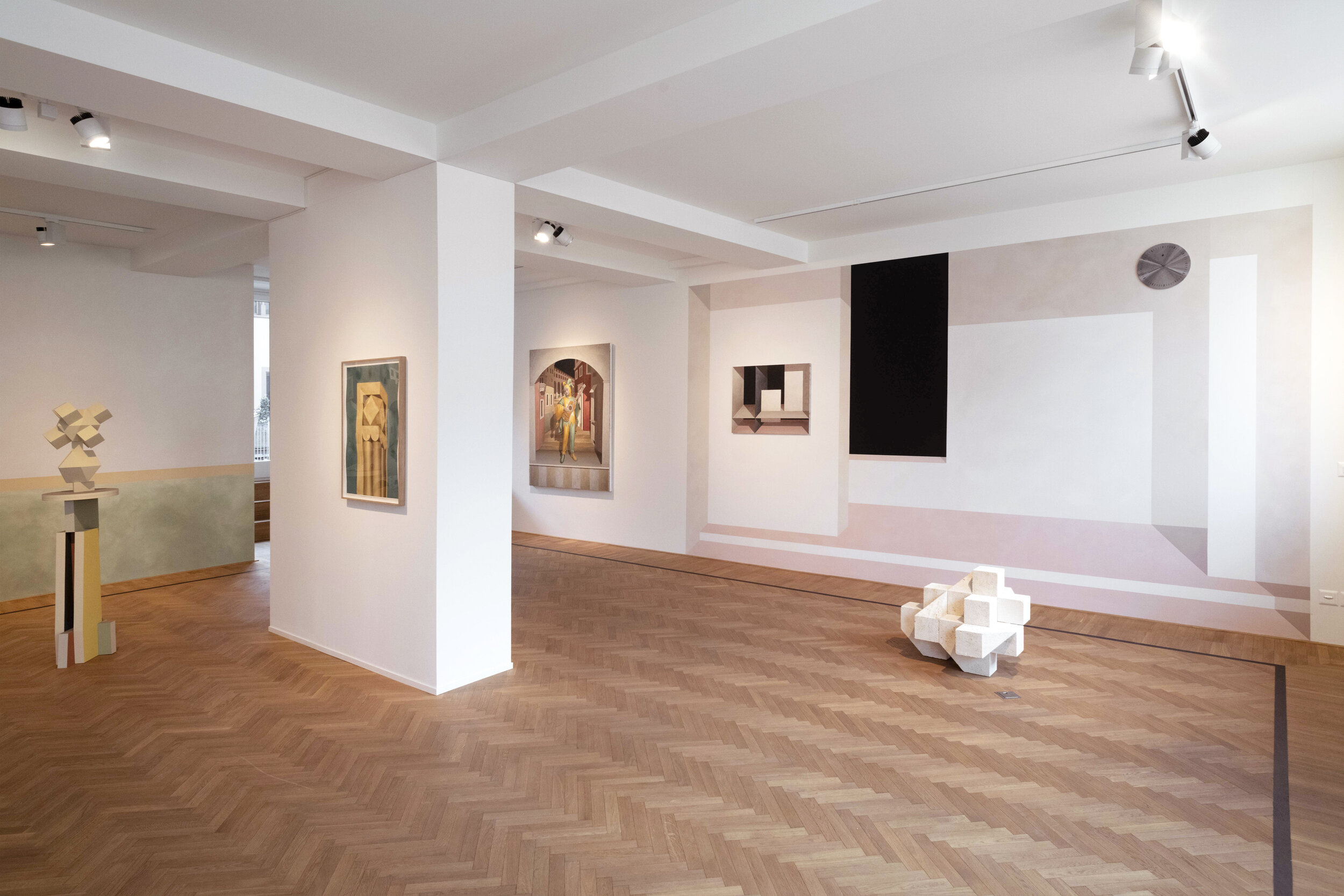
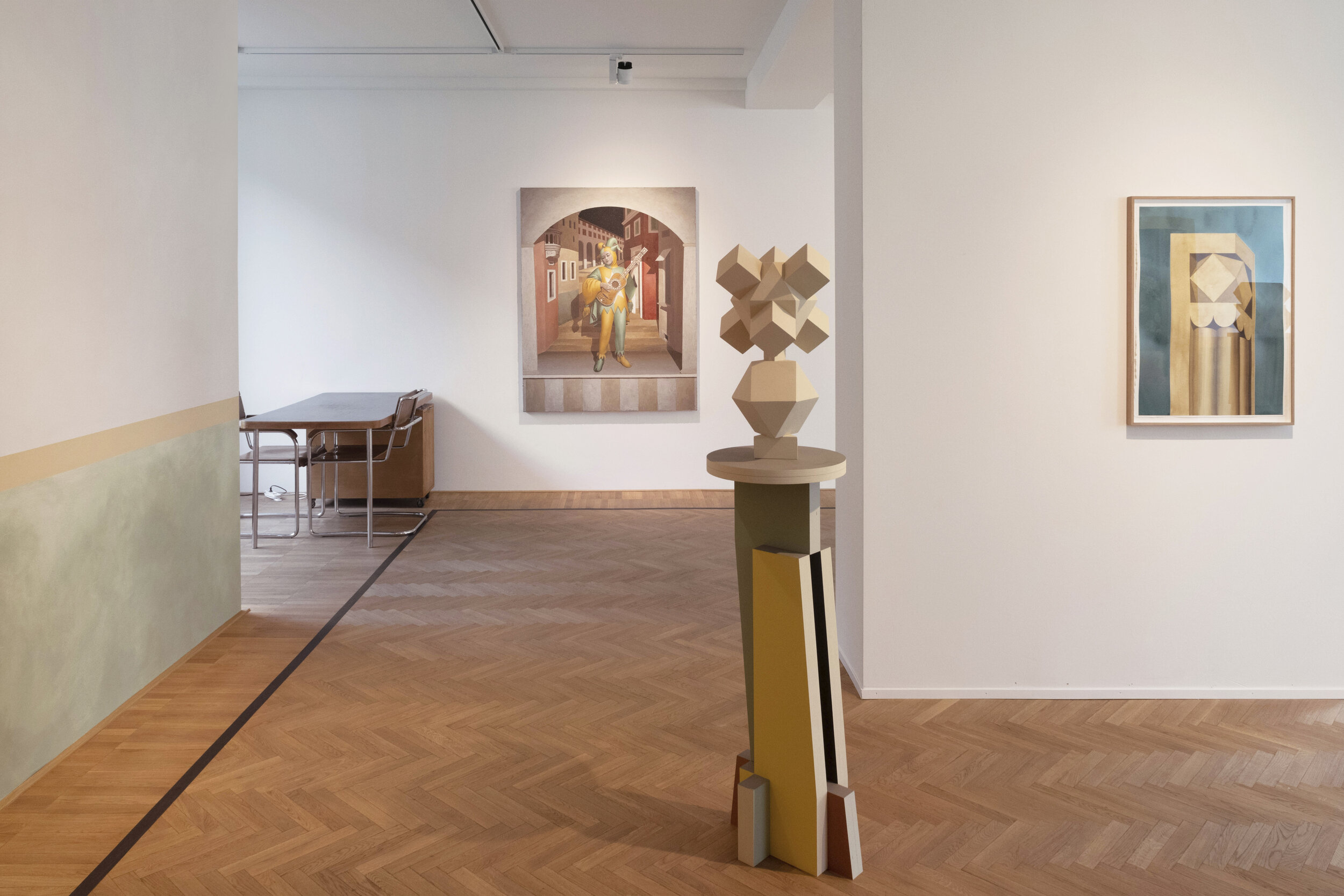
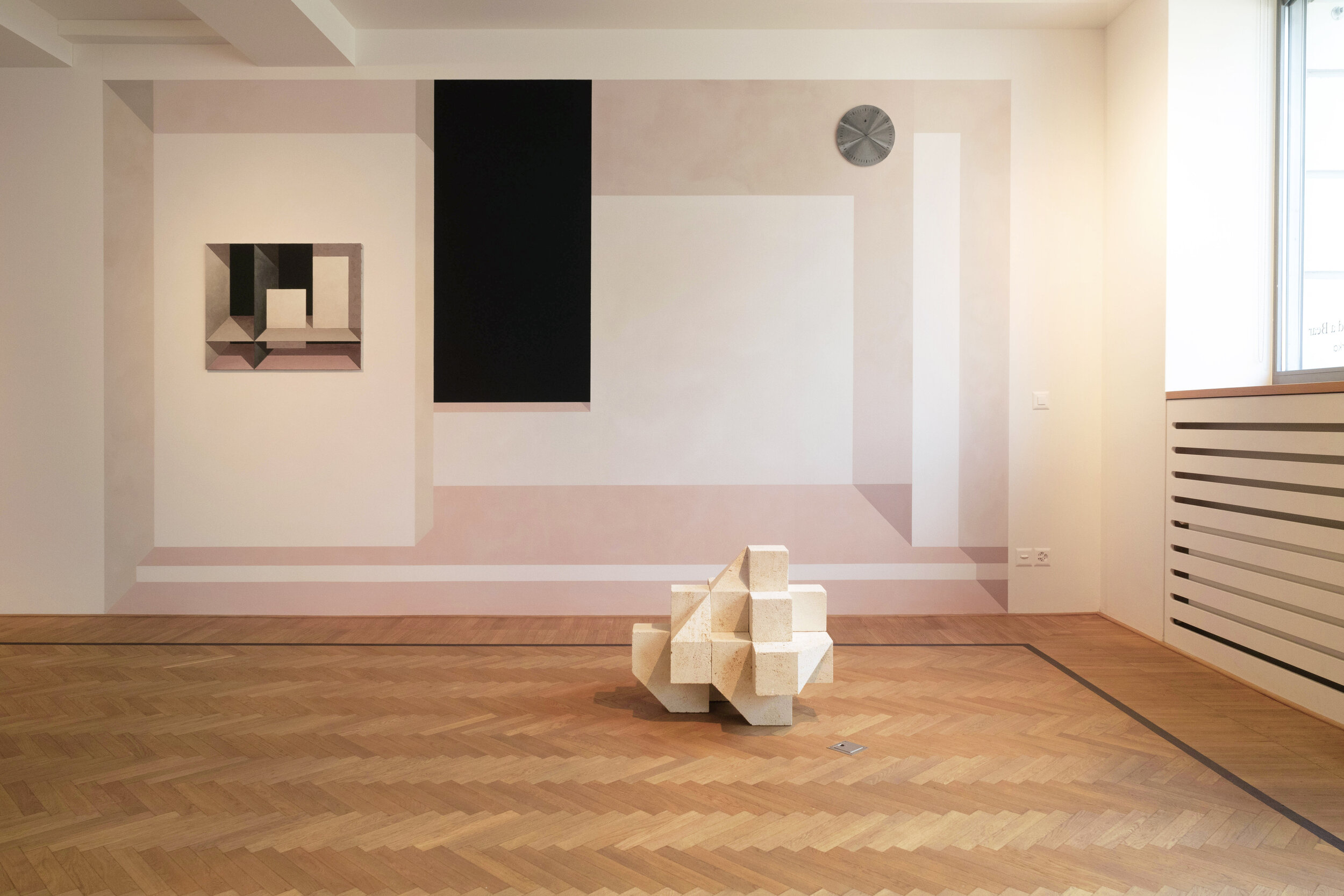
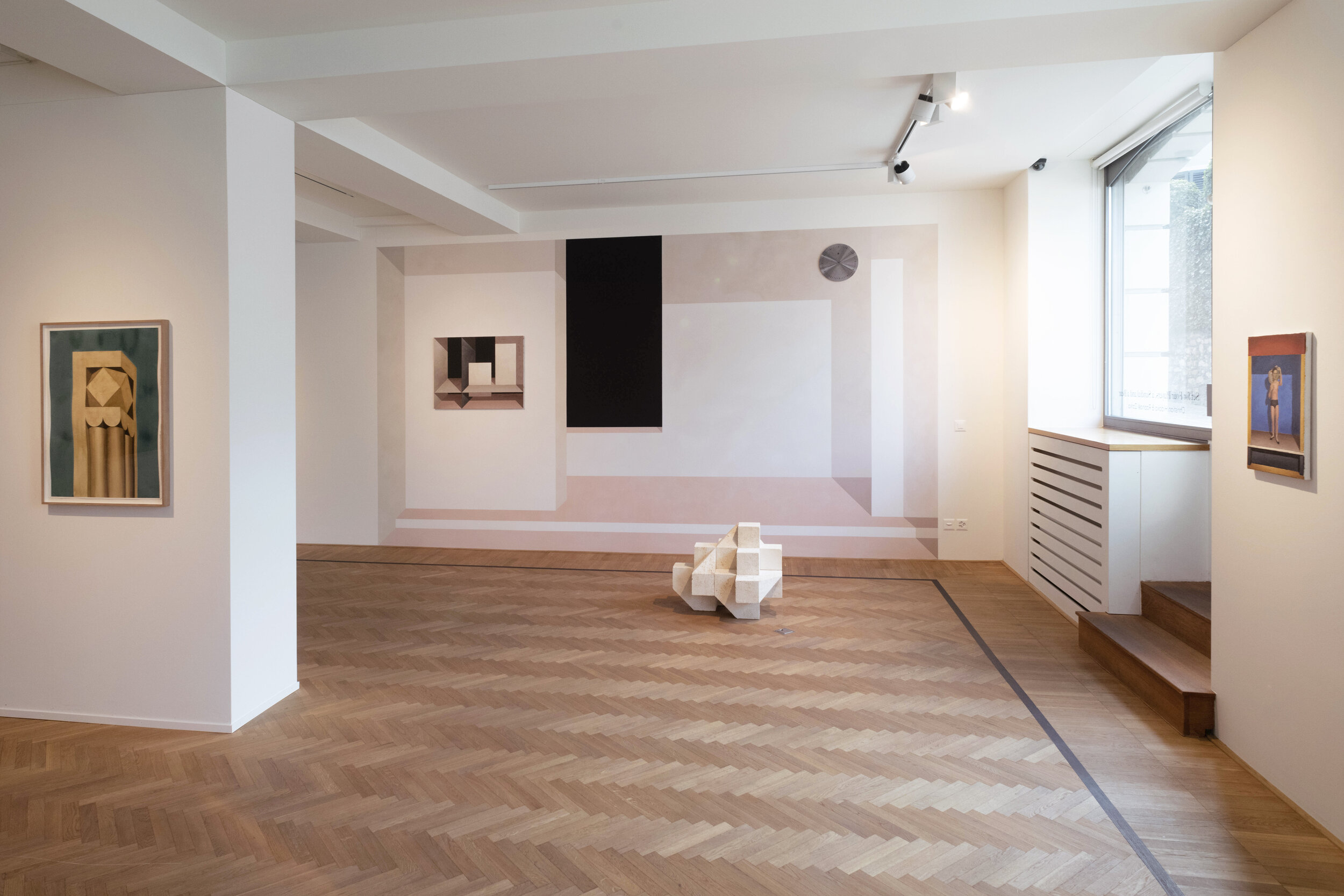
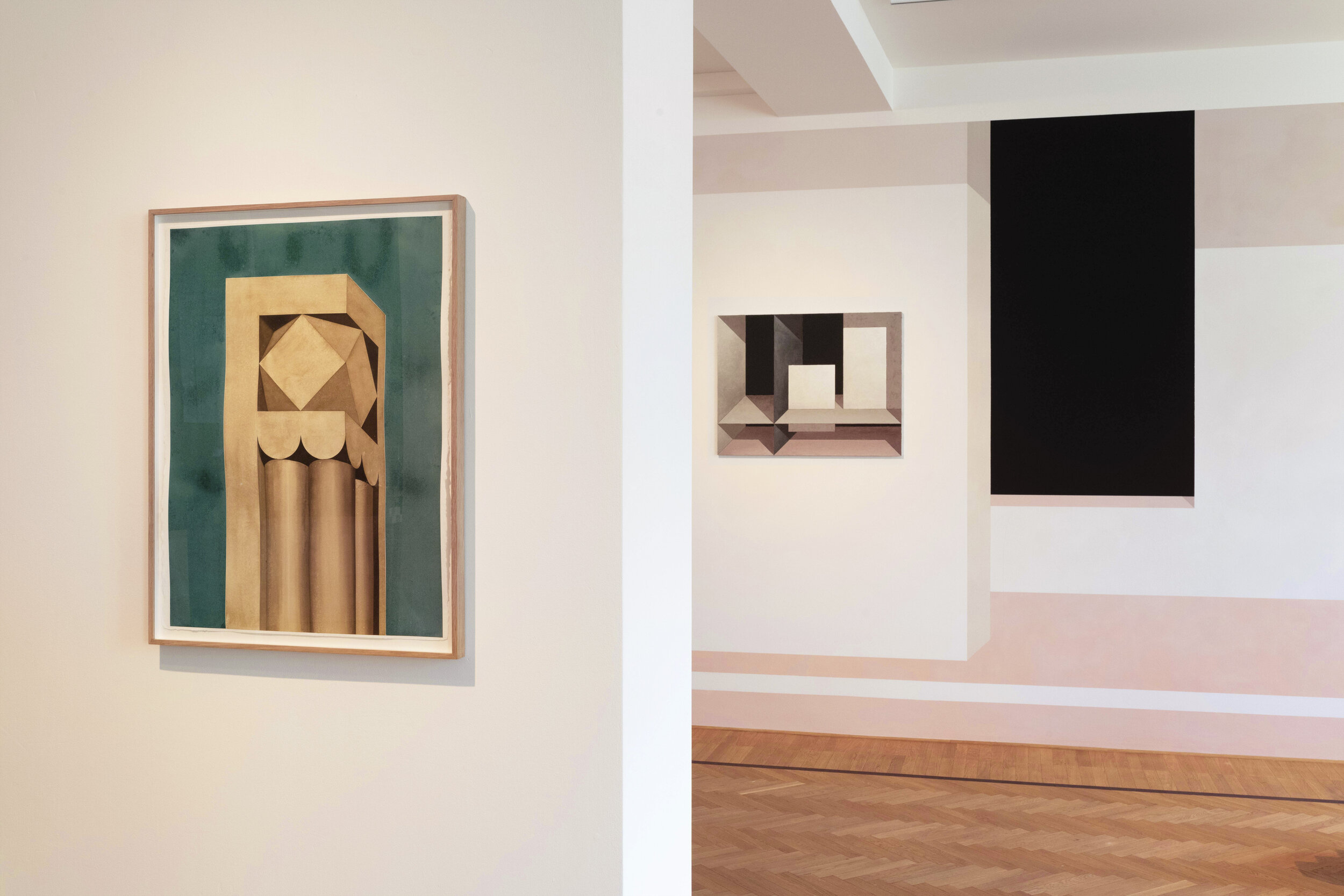

Explore the exhibition virtually below. Click the tabs or move the mouse to navigate through the space. Click on the works to open up a pop up window for more information and a high res image.
Exhibited works: (upstairs)
Downstairs
Press release (Deutsche Version weiter unten verfügbar)
[pdf]
Raphaël Zarka and Christian Hidaka’s exhibition ‘Set for Four Players, a Sundial and a Bear’, marks the continuation of an ongoing artistic dialogue and is their first presentation in a gallery setting. Their respective practices meet to explore and meditate on forms of knowledge, whilst exposing the tensions between permanence and transience.
At first glance the practices of both artists appear to be invested in forms of historicism, made apparent through the use of both historical media and forms of visual language. This would seem to demonstrate an awareness of art’s timeliness, but in looking at the past, or at the peripheries of art making (decorative art, illustrations for perspective manuals, objects made by scientists, etc.) both Zarka and Hidaka’s work goes beyond an archaeological view of Western Art to explore a space for improvisation and translation.
Advancing a consciously staged exploration of the space, the artists transform the white cube into an immersive tableau. The artworks display a singular, unified and conceptually consistent quality, enhanced by the room sized fresco secco mural designed by Hidaka in collaboration with Zarka. Spanning the gallery, this mural, in oblique projection, creates an integrated backdrop for the sculptures and paintings, reinforcing the multi-layered network of references, symbols and geometric motifs that can be found in the works displayed within it.
Hidaka’s painting, ‘Kirby Construction’, which takes its composition from an engraving found in John Joshua Kirby’s, ' …Perspective Made Easy’ (1768) is an abstract spatial construction featuring a series of interlocking planes. Instead of following Kirby’s instruction in one-point perspective, Kirby’s diagram itself has become the site of Hidaka’s enquiry. This painting hangs on a mural composition that depicts a recessed section of wall constructed in oblique projection. In front of this, standing on the floor, is ‘Emma Schoenflies’ by Zarka, a limestone sculpture made after a small plaster model by Arthur Schoenflies in 1891 displaying his crystallographic research. Following his investigation into the use of semi-regular polyhedra in art and science, Zarka’s attraction to Schoenflies’ models is based on their ‘sculptural potential’ and a sense of pseudomorphosis; the models could be seen as perfect examples of Suprematist and Constructivist sculpture several decades before their time.
Zarka always qualifies his works as ‘documentary sculpture’, sculptures using the vocabulary of abstraction through the reproduction of pre 20th century objects, made at the periphery of art. ‘Lavaur’, is part of the recent ‘Gnomonic Sculpture’ series, a totemic form made from stacked wood and concrete, modelled after a polyhedral sundial which was dredged up in the early 1900s from the riverbed in the town of Lavaur, southern France. Dated to around the time when George de Selves (who appears as one of the two figures in Holbein’s ‘Ambassadors’ (1533), with a wooden polyhedral sundial next to him) was Bishop of Lavaur, the question is open as to whether the original sundial was possibly owned by him. Its metaphysical qualities are echoed by Hidaka’s ‘Angelico Door’, a life-size painting of a doorway originally located as a small detail within the ‘Apparition of St Francis at Arles’ (1429), a painting by Fra Angelico. Zarka’s documentation of existing forms and their translation into artworks is complemented by Hidaka’s use of imagery invoking the affinities between painting, theatre and memory.
In this exhibition, George de Selves, Arthur Schoenflies, Fra Angelico, Peter Halt and John Joshua Kirby are joined by a bear, resident in Hidaka’s ‘Large Scene with Clown and Bear’. Each character informs the exhibition’s proposition and they are cryptically drawn together, linked by their involvement in mathematics, crystallography and perspective; yet despite this, in the staging of the exhibition, any allusion given to rational pursuits gives way to mystery and ambiguity.
(With special thanks to Christophe Felix Maier for mural production)
Pressetext
[pdf]
„Set for Four Players, a Sundial and a Bear” ist für Raphaël Zarka und Christian Hidaka die erste Ausstellung in einem Galeriekontext und zugleich die Fortsetzung einer andauernden, künstlerischen Zusammenarbeit, bei der sich ihre respektiven Praktiken in einer Erkundung unterschiedlicher Formen von Wissen dialogisch verflechten. In ihrer Auseinandersetzung machen beide Künstler die Spannungen zwischen Permanenz und Vergänglichkeit sichtbar.
Auf den ersten Blick scheinen sich beide Künstler mit Formen des Historizismus zu befassen, der sich im Gebrauch von historischen Artefakten und ihrer jeweiligen Art visueller Sprache augenscheinlich macht. Dies könnte zunächst als Verweis auf die Zeitlichkeit von Kunst gelesen werden – doch sowohl Zarka als auch Hidaka gehen mit ihrem Blick in die Vergangenheit und in die Peripherien des Kunstschaffens (dekorative Kunst, Illustrationen für Handbücher zur perspektivischen Darstellung, wissenschaftliche Objekte, etc.) über den archäologischen Blick westlicher Kunst hinaus, um stattdessen in ihren Arbeiten einen Ort der Improvisation und Translation zu erkunden.
In einer Weiterführung der bewusst inszenierten Erkundung des Raums transformieren die Künstler den White Cube in ein immersives Tableau. Die Kunstwerke zeichnen sich durch eine singuläre, einheitliche und konzeptionell konsequente Qualität aus, die durch das von Hidaka in Zusammenarbeit mit Zarka entworfene raumgroße Fresko-Secco-Wandbild unterstrichen wird. Das die Galerie umspannende Wandgemälde bildet in der Schrägprojektion den Hintergrund für die Skulpturen und Bilder und verstärkt damit das vielschichtige Netzwerk an Referenzen, Symbolen und geometrischen Motiven, das aus den ausgestellten Werken hervorgeht.
Hidakas Gemälde „Kirby Construction“ ist eine abstrakte, räumliche Konstruktion aus einer Reihe von ineinandergreifenden Ebenen, deren Komposition an Joshua Kirbys "…Perspective Made Easy" (1768) angelehnt ist. Statt jedoch Kirbys Anleitung zur Zentralperspektive zu folgen, wird für Hidaka Kirbys Diagramm selbst ein Ort der Hinterfragung. Dieses Gemälde hängt an einer Wandkomposition, die einen vertieften Wandabschnitt darstellt, der durch eine Schrägprojektion konstruiert ist. Davor auf dem Boden befindet sich "Emma Schoenflies" von Zarka, eine Kalksteinskulptur, die an einem kleinen Gipsmodell von Arthur Schoenflies aus dem Jahr 1891 orientiert ist, das kristallografische Forschungsergebnisse des Wissenschaftlers abbildet. Als Fortsetzung seiner Auseinandersetzung mit semiregulären Polyedern in Kunst und Wissenschaft gründet sich Zarkas Faszination mit Schoenflies' Modellen im skulpturalen Potenzial und der pseudomorphotischen Aufladung der Figuren. Die Figuren können als perfektes Beispiel für suprematistische und konstruktivistische Skulpturen gesehen werden — mehrere Jahrzehnte vor ihrer Zeit.
Zarka ordnet seine Arbeiten stets als "documentary sculpture" ein: Als Skulpturen, die sich eines Vokabulars der Abstraktion bedienen und damit Objekte aus den Peripherien der Kunst reproduzieren, die vor dem zwanzigsten Jahrhundert entstanden. "Lavaur" ist Teil der "Gnomonic Sculpture"-Serie, eine totemhafte Form aus gestapeltem Holz und Beton, die nach einer polyedrischen Sonnenuhr modelliert ist, die zu Beginn des zwanzigsten Jahrhunderts aus einem Flussbett in Lavaur, Südfrankreich ausgegraben wurde. Die Frage, ob die originale Sonnenuhr möglicherweise George de Selves, dem damaligen Bischof von Lavaur gehörte, bleibt ungeklärt — Selves taucht als eine der beiden Figuren in Holbeins "Die Gesandten" (1533) auf und ist dort mit einer hölzernen, polyedrischen Sonnenuhr neben sich abgebildet. Die spezifische metaphysische Qualität dieser Skulptur findet sich in Hidakas "Angelico Door" wieder, einem lebensgroßen Bild eines Türrahmens, der ursprünglich als kleines Detail im Gemälde "Erscheinung des Heiligen Franziskus in Arles" (1429) von Fra Angelico auftaucht. Zarkas Dokumentation von existierenden Formen und ihre Übersetzung in Kunstwerke wird von Hidakas Bildsprache komplementiert, die eine Affinität zu Malerei, Theater und Erinnerung evoziert.
Schließlich gesellt sich zu George de Selves, Arthur Schoenflies, Fra Angelico, Peter Halt und John Joshua Kirby ein Bär, der in Hidakas "Large Scene with Clown and Bear"’ beheimatet ist. Verknüpft durch ihren Einfluss auf Mathematik, Kristallografie und Perspektive sind die einzelnen Charaktere auf kryptische Art und Weise miteinander verbunden. Jede der Figuren beeinflusst damit die These, die die Ausstellung in den Raum stellt — und dennoch: Jegliche Andeutung von Rationalität weicht in der Inszenierung schlussendlich Ambiguität und Rätselhaftigkeit.
(Ein besonderer Dank gilt Christophe Felix Maier für die Produktion der Wandmalerei)
